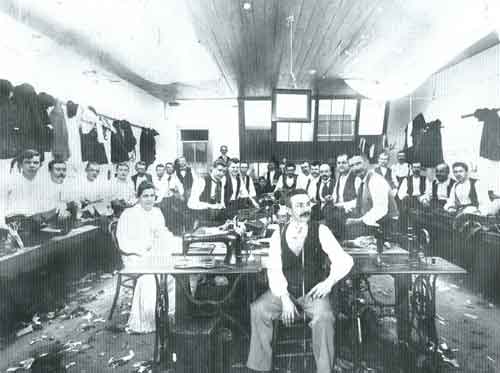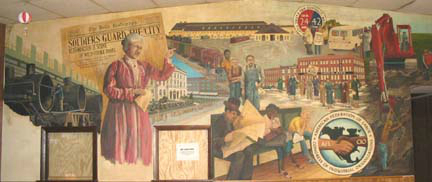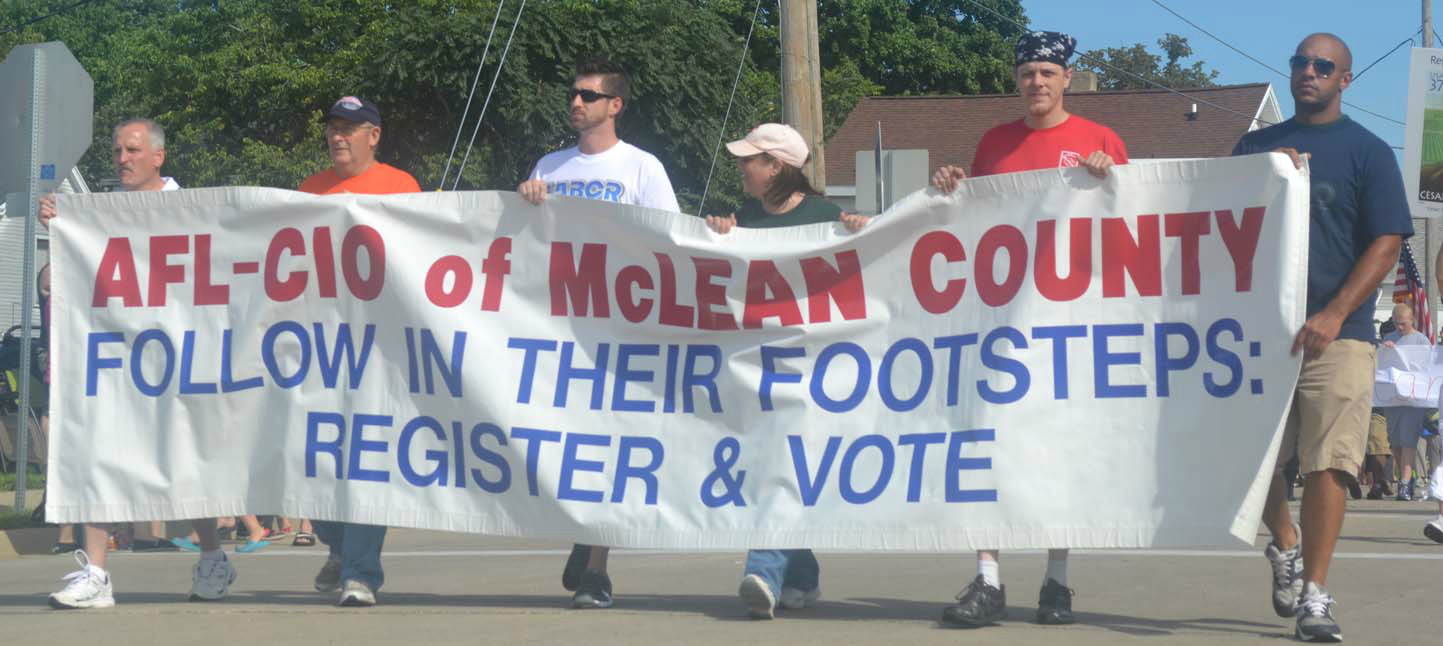
|
| These tailors represent the craft tradition, as they worked in downtown Bloomington. (Courtesy of McLean County Historical Society) |
|
Although William Sylvis of the Moulders attempted forming a national trade union organization in 1866, the first truly national labor federation was the Knight of Labor, organized in Philadelphia in 1869. The Knights believed in organizing workers to form a "cooperative commonwealth." Like the early Republican Party, the Knights defined "producers" broadly, accepting small business and farmers into their secret society ranks. The Knights condemned strikes, and instead encouraged cooperative enterprises and political action.
With a simultaneous appeal to the laboring classes as citizens and as producers, the Knights of Labor effectively reached out in the 1880s from a base among artisans and coal miners to a cross-class constituency, including small shopkeepers, even a few manufacturers, and a growing factory proletariat. ...The result was an economic and cultural solidarity extending beyond a given class or corporate interest (Fink, 92).
The Knights first appeared in Bloomington in 1882. By February 1883 they had six assemblies, including one for women, with a membership of 1,200. That month they incorporated a cooperative store ("The Knights", 3).
Two months later, in April 1883, the Knights made their first political move in the city, running a candidate for Mayor. Charles Strehorn, a C&A shops machinist, was nominated. The Pantagraph characterized Strehorn favorably, saying:
He is a machinist by trade and is recognized as a very superior mechanic. He has worked in the C&A shops in this city for the past fourteen or fifteen years... He has always been a republican, though he has never been identified with politics in any manner.... He is a prominent member of the Knights of Labor, and among the working men generally he is a favorite. He is well educated, versed on the general topics of the day and makes an intelligent appearance. He is a modest and unassuming gentleman and talks but little, though he is an interesting and intelligent conversationalist, and should he be elected he would make a good mayor. ("Strehorn", 3).
Strehorn was defeated, coming in third behind Democrat John W. Trotta with 1,802 votes and Republican Issac Phillips with 1,141. Strehorn still won 854 votes and the election day newspapers commented on the Knights well-organized effort, with numerous carriages ferrying voters to the polls ("Election results," 4).
The Bloomington Knights sent a delegate, T.S. Schofield, to represent them at the 1884 founding of the Illinois Federation of Labor at Chicago's Seaman's Hall. Schofield was elected a vice-president at the founding convention and was a regular delegate to these early statewide labor gatherings (Staley, 52).
Workers eager for organizational representation flocked the Knights, but the organization was all but gone by the new century. Workers affiliated with the Knights won strikes, successfully in Illinois on the Wabash Railroad in 1885. These job actions attracted new recruits and workers participated in the "Great Uprising," a huge increase in strike activity. "Grand Master Workman" Terrence Powderly emphasized political action, education and cooperative ventures, condemning job actions and strikes. Many workers became disgusted with the Knights' lack of strike support and looked for a new answer. And in many cases the Knights were simply overwhelmed by the outbreak of worker activity. From an average of 450 strikes a year in the early 1880s, 1886-87 saw over 1,400 job actions annually (Laurie, 156).
Newspapers, political debates and popular discussion of the late 19th century often centered around the "labor question." Rising corporations and the amassed new fortunes of George Pullman, Cornelius Vanderbilt, J.P. Morgan, Andrew Carnegie and John D. Rockefeller both fascinated and enraged Americans. The Jeffersonian ideal of equality, based on productive farmers and craft workers, was challenged by new wealth and power. Wholesale bribery of legislators and judges insured control to emerging corporate power. Workers laboring for distant railroad magnates or factory owners were often powerless to resist. Spontaneous strikes might occur, but both economic and political power rested with wealth.
The 19th century's other fascination, technology and science, was marshaled to serve this new system. Frederick Winslow Taylor popularized a new concept he christened "Scientific Management." Taylor infiltrated the working class to learn its secrets. He left his upper-class world behind and was trained as a machinist. In a world where workers still had some power through their control of craft and skill, Taylor carefully dissected those skills, reducing them to simpler processes. His method reduced workers to "hands," doing simplified, repetitive work, carefully timed by a foreman to increase productivity. "Taylor proposed two basic industrial reforms. The first would cut away from the brain work inherent in what workers did and place it wholly in the hands of the managers. ...The second reform...would deprive workers of the responsibilities they had normally exerted on the shop floor (Brody, 11-12)."
Taylor system was kind, compared to the rampant child labor, low wages and often abusive working conditions of the time. Workers had tried political and education agitation through organizations like the Knights. Was there other, more effective alternative? Some took the Knights' "cooperative commonwealth" and pushed the idea further, wanting to establish socialist or anarchist economic systems. Utopian colonies, where wealth would be shared, were also often advocated.
"Pure and simple trade unionism" was another alternative, preached by cigar maker Samuel Gompers and carpenter Peter J. McGuire. Rather than political reform, socialist politics or cooperative schemes, this group advocated power for workers through controlling work. They would not challenge capitalism, rather their scheme was to unite workers, on the basis of a trade or craft, to use their skills to negotiate wages, hours and conditions in a particular area. "For craft workers trade unionism was functional, an immediate part of their day-to-day life on the job, and above all, the protector of traditional skills and prerogatives (ibid, 22)."
In 1881 many of the nation's early trade unions banded together to form the Federation of Organized Trades & Labor of the United States and Canada. This weak effort faltered and was reorganized in 1886 in Columbus, Ohio as the American Federation of Labor (AFL), electing Samuel Gompers its first president. A similar statewide effort happened in Chicago, when the Illinois State Federation of Labor organized in 1884 at Seamen's Hall.
An issue that united workers was hours. Ten, twelve and fourteen hour work days were common. Workers had agitated against longer hours for years; Illinois was a leader in passing an eight hour law in 1867, but it was a sham. The weakly worded legislation said eight hours would be the workday, unless agreed to differently by both employer and employee. Although supported by the Republican majority and Governor Oglesby in Springfield, the law collapsed when manufacturers ignored it and workers destroyed machinery in frustration (Montgomery 309-310). Seeking to put their new organization on the map, the Federated Trades at their convention in Chicago in 1884 passed a resolution by Gabriel Edmonston of the Carpenters, calling for universal enforcement of the eight-hour day by May 1, 1886.
Workers flocked to join both the Knights and the new AFL, inspired by the eight-hour day rhetoric. The popular slogan was "eight hours for work, eight hours for rest, eight hours for what we will." 350,000 workers participated in demonstrations nationally and about 185,000 of them actually won an eight-hour day, thanks to the agitation.
But the euphoria was short-lived. Union iron moulders at the McCormick Reaper works in Chicago were locked-out by that large employer on February 16. Following the eight-hour agitation, 6,000 striking lumber workers rallied near McCormick's plant on May 3. As the strike-breakers left the reaper works, they were confronted by the rally. Inspector John Bonfield of the Chicago Police rushed to the scene and fired into the crowd, leaving two union supporters dead.
Enraged, August Spies, editor of the German language labor paper Arbeiter-Zeitung, printed a flier, calling for a mass rally the next evening in Chicago's Haymarket Square.
May 4, 1886 would become an infamous date in labor history. As the small Haymarket Square rally dispersed, following a light drizzle, Chicago Mayor Carter Harrison, who quietly left the rally, stopped by the nearby police station and told Bonfield to disperse his forces. Ignoring the Mayor, Bonfield instead marched on the dwindling rally. As Bonfield approached, ordering the rally to disperse, a dynamite bomb, thrown by an unknown assailant, landed in the middle of the police ranks. Mathias Degan, a police officer, was killed. Six other officers were killed in the resulting melee, along with three workers.
The next day martial law was declared in Chicago. The eight-hour movement, which had proved a unifying point for the emerging labor movement, was labeled as socialist and anarchistic. Eventually eight labor leaders, primarily German immigrants and most of strong anarchist sentiments, were convicted of the crime. None were directly implicated and most were nowhere near the sight when the bomb exploded. Albert Parsons, August Spies, Louis Lingg, Adolph Fisher and George Engel were sentenced to death. Lingg committed suicide in his cell. Samuel Fielding and Michael Schwab were sentenced to life imprisonment and Oscar Neebe was given fifteen years. On November 11, 1887, while Chicago's financial elite sat in front row seats, the four were hung by the neck, Parsons shouting, "Let the voice of the people be heard" as the gallow's trap sprung.
On June 26, 1893, Illinois Governor John Peter Altgeld pardoned the three remaining convicts, labeling the trial a travesty of justice.
The Bloomington Pantagraph's reaction to Haymarket was similar to that of newspapers across the nation, editorially commenting on May 7, 1886:
The boycott, the strike, the socialist and the anarchist...must all go into a state of innocuous desuetude... A Chicago policeman remarked that the men had been in the habit of shooting over the heads of rioters for fears they might knock out a voter, but they proposed to shoot low hereafter. Shoot low should be the motto of police and militia henceforth in dealing with mobs ("Anarchists," 4).
Illinois legislators reacted by passing two laws in 1887, the Cole Anti-Boycott Law and the Merritt Conspiracy Law. The Cole law was aimed at preventing labor's use of consumer boycotts. The law stated that "if two or more persons conspired together or the officers or the executive committee of any society or organization uttered or issued any circular or edict instructing its members to institute a boycott or black list, they shall be deemed guilty of conspiracy (Karno, 3)."
Although not politically sympathetic to the anarchist tendencies of the Haymarket defendants, AFL President Samuel Gompers traveled to Springfield, pleading for a pardon. "We stand for a fair trial for the underdog, whether called anarchist or any other name," Gompers said.
The AFL did not give up the dream of a eight-hour day. In 1889 Gompers dispatched Hugh McGregor to the International Workingmen's Congress in Paris. The Congress adopted May 1 as a universal date to agitate for the eight-hour day, beginning an global tradition of worker holidays on Mayday that survived everywhere but its country of origin, the USA. As national law, the eight-hour day did not come until 1938, when President Franklin Roosevelt passed the Fair Labor Standards Act, ending child labor, establishing the minimum wage and setting the workday as eight hours.
Despite the sullied reputation labor carried from the Haymarket affair, the "pure and simple unionism" that Gompers advocated quickly grew in McLean County during the 1890s. Craft unions organized, especially in the railroad shops and the construction trades, plus amongst mining and some industrial trades. In the rail shops Boilermakers Lodge 24 (1890), Machinists Lodge 342 (1901), Blacksmiths Local 79 (1902), Coach Painters Local 766 (1902), Coach Carpenters Local 1219 (1906) and Boilermakers 222 (1907) were organized. Building trades unions formed included Plumbers 99 (1891, reorganized in 1899), Bricklayers 19 (1892), Painters 209 (1898), Carpenters 63 (1899), Wood and Wire Lathers Local 61 (1900), Building Laborers Local 12 (1900), International Brotherhood of Electrical Workers (1901) and the International Association of Steam Fitters (1907). In 1899 these organizations banded together to form the Bloomington Building and Construction Trades Council.
Other crafts organizing during this time included Barbers Union (1892), Butcher Workman (1893), Teamsters Local 43 (1893), Letter Carriers Branch 522 (1895) Musicians 102 (1899), United Mine Workers 753 (1899), Retail Clerks Local 92 (1900), Garment Workers 118 (1900), Brewery Workers 287 (1901), Bookbinders 127 (1902), Printing Pressman Local 41 (1902), Leather Workers Branch 131 (1903) and Theatrical Stage Employees Local 193 (1910). Most of these organizations operated in Bloomington, though Chenoa coal miners also affiliated with the United Mine Workers.
This growth paralleled the national rise of the AFL. Building trades unions grew from 67,000 members in 1897 to 391,600 in 1904, while transportation union membership leaped from 116,000 to 446,300. The United Mine Workers went from 447,000 members to over two million in the same period (Brody, 24).
Not all of these organizations achieved immediate success and some were numerically small, though representing their craft in the community. For instance, the United Mine Workers organized Local 667 in Bloomington in 1894, winning a five cent per ton increase after a four month strike. In 1897 the miners struck again for three months but support was weak. In 1898 union members were no longer allowed to work at the McLean County Mine. But one year later the miners were again agitating to organize and formed Local 753 (Prince & Burham, 887-890).
Although these unions were primarily made up of white males, there were some female members, represented primarily by Garment Workers Local 118, which had contracts in some of the local clothing factories. There were also women's auxiliary organizations established by the early 1900s, primarily amongst railroad workers wives. The Locomotive Engineers (1890), Railway Conductors (1896), and the Railway Trainmen (1901) all had active auxiliary organizations. Although primarily social, these organizations helped spread trade union principles amongst spouses and acted as support systems for union actions.
Recognizing their new power and strength in the community, these trade unions banded together to establish the Bloomington Trades & Labor Assembly in 1891, affiliated originally with the Knights of Labor and the Illinois State Federation of Labor and after 1902 with the American Federation of Labor. The Trades & Labor became the unified voice for local unions, endorsing political candidates, supporting strikes and organizing campaigns, and promoting public outreach by the local unions. The original president was iron moulder Thomas M. Hibler.
In establishing itself, the new local labor federation sternly evaluated the economic conditions they confronted:
Year after year the capital of the country becomes more concentrated in the hands of the few; and in proportion as the wealth of the country becomes more centralized, its power increases and laboring classes are impoverished. It therefore becomes us as men who have to battle with stern realities of life, to look this matter fair in the face.
They saw their strength in collective action on all unions, stronger than any one organization,
...through which all branches of labor may prove allies to any particular one that may be oppressed, and all may form one Brotherhood for the defense and protection of the laboring classes (Bloomington, 1).
After declaring that labor produces all wealth and all should have equal access to the land, they urged all workers to register to vote, called for businesses closing on Sundays, enforcement of child labor laws, equal pay for equal work for both sexes, an end to prison labor and the establishment of the eight-hour day (ibid, 2-3).
|



